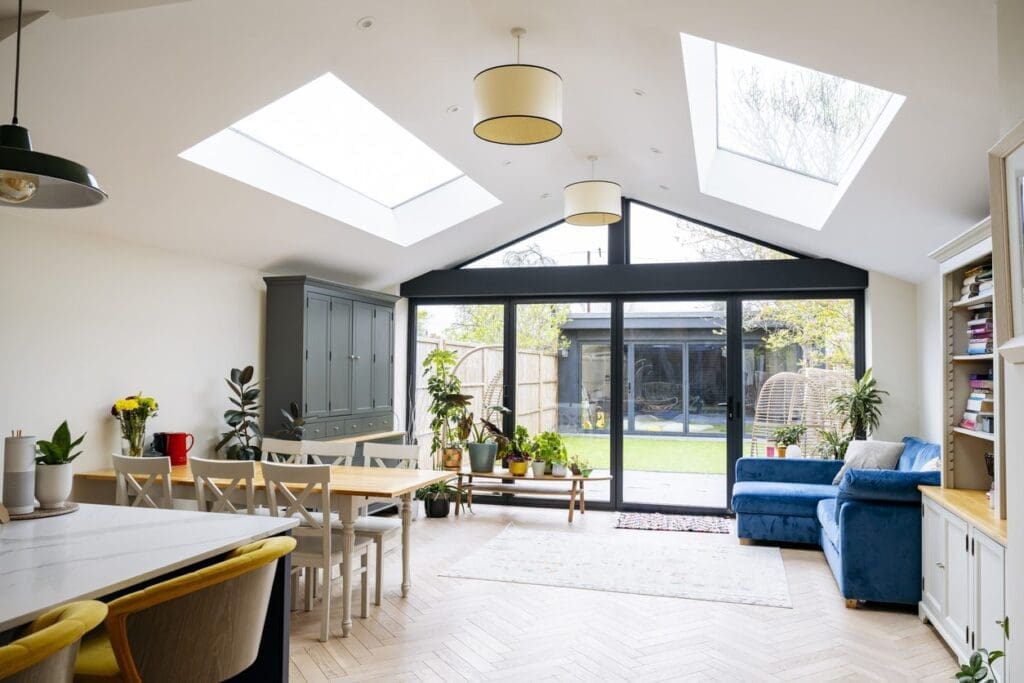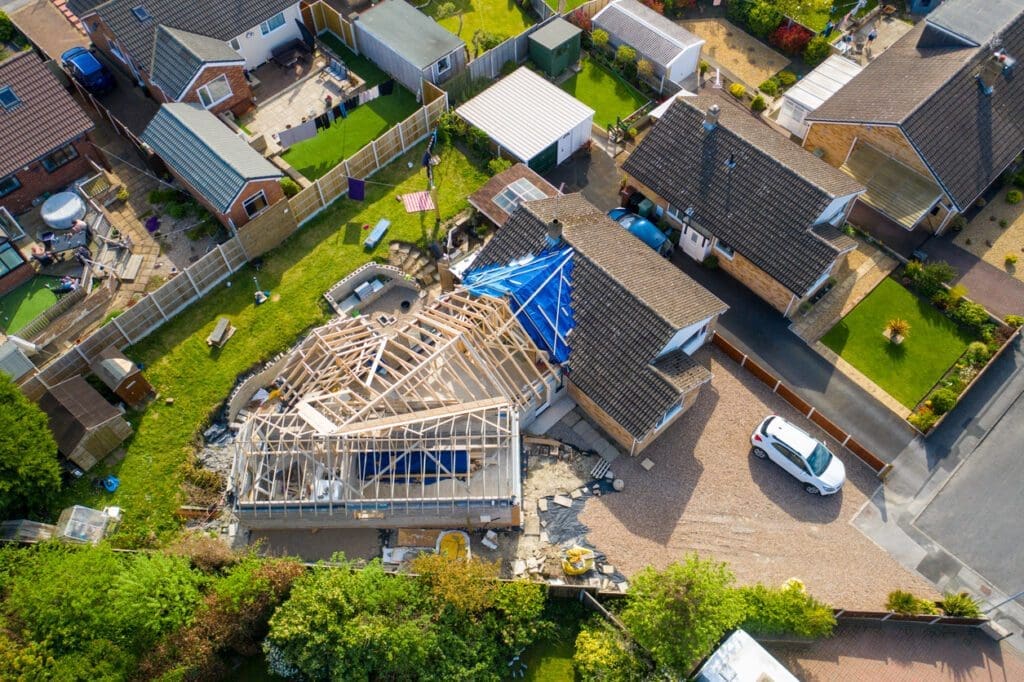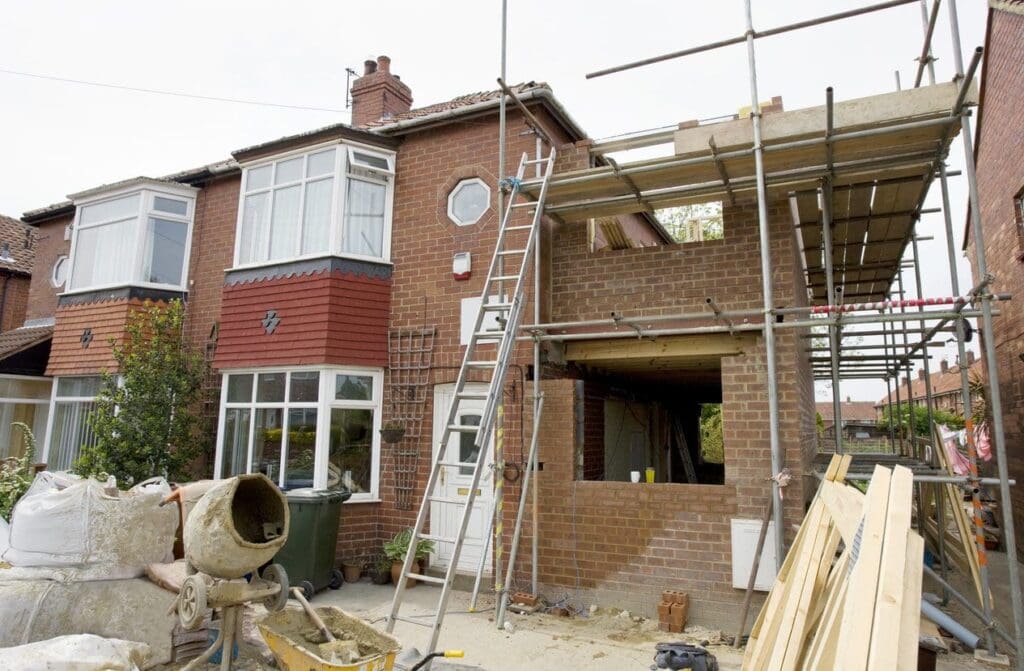What are permitted development rights?
Permitted development rights allow you to extend or alter your house without applying for planning permission. These rights are granted nationally through legislation called the Town and Country Planning (General Permitted Development) Order.
Key point: Permitted development rights are a type of planning permission granted in Statute. They allow certain building works to be carried out without having to apply for planning permission through your local authority.
Permitted development rights apply to many common home improvements including:
- Extensions
- Loft conversions
- Outbuildings and garden rooms
- Garage conversions
- Porches
However, these rights come with specific conditions and limitations. If your proposed works don’t meet all the criteria, you’ll need to apply for planning permission.
Single-storey rear extensions
You can build a single-storey rear extension without planning permission if:
- It extends no more than 4 metres from the original house for a detached house, or 3 metres for any other house
- It’s no higher than 4 metres
- It doesn’t cover more than 50% of the land around the original house
For larger single-storey rear extensions up to 8 metres (detached houses) or 6 metres (other houses), you can use the prior approval process under Class A paragraph A.1(g). This requires you to notify your local council and they’ll consult your neighbours.
Two-storey rear extensions
Two-storey extensions (including first floor extensions above existing extensions) can be built under permitted development if they:
- Don’t extend beyond the rear wall by more than 3 metres
- Are at least 7 metres from the rear boundary
- Have a roof pitch that matches the existing house as far as practical
- Use similar materials to the existing house
Side extensions
Side extensions can be built under Class A permitted development if they:
- Are single-storey
- Are no wider than half the width of the original house
- Are no more than 4 metres high
- Don’t front onto a highway
Roof extensions and loft conversions
Under Class B, you can extend your roof space by adding dormer windows or other roof extensions if:
- The new roof doesn’t extend beyond the highest part of the existing roof
- The extension doesn’t go beyond the front roof slope that faces a highway
- The volume increase doesn’t exceed 40 cubic metres for terraced houses or 50 cubic metres for other houses
- Similar materials are used to those of the existing house
Side-facing windows must be obscure-glazed and non-opening unless parts that open are 1.7 metres above floor level.
Additional storeys
Class AA allows some houses to be extended upwards by adding storeys if:
- The house was built between 1 July 1948 and 28 October 2018
- The existing house hasn’t already been extended upwards
- The new roof height doesn’t exceed 18 metres
- The height increase doesn’t exceed 7 metres (two-storey house) or 3.5 metres (one-storey house)
This requires prior approval from the local planning authority for impacts on amenity, external appearance, and other factors.
Garden rooms and outbuildings
Garden rooms fall under Class E of permitted development rights as “buildings incidental to the enjoyment of a dwellinghouse.”
You can build a garden room or outbuilding without planning permission if:
- It’s within your property’s curtilage (garden/grounds)
- It doesn’t cover more than 50% of the land around the original house
- It’s not positioned forward of the principal elevation
- It’s single-storey with maximum eaves height of 2.5 metres
- The overall height doesn’t exceed 4 metres with a dual-pitched roof, or 3 metres for any other roof
- If within 2 metres of a boundary, the height doesn’t exceed 2.5 metres
- It doesn’t include a veranda, balcony or raised platform
Key point: Garden rooms must be for purposes “incidental” to your main house like a home office or gym. They cannot be used as primary living accommodation or separate dwellings without planning permission.
In conservation areas and other protected land, outbuildings cannot be placed between the side of your house and the boundary, and must not exceed 10 square metres if positioned more than 20 metres from the house.
Garage conversions
Converting an attached garage to living space is usually permitted development under Class A if:
- The work is internal and doesn’t extend beyond the existing garage
- There are no planning conditions restricting the garage’s use
- The property isn’t in an area with Article 4 directions removing these rights
Converting detached garages may require planning permission, especially if changing to habitable use. Both types of conversion will require building regulations approval.
Porches
Under Class D, you can add a porch to any external door of your house without planning permission if:
- The ground area (measured externally) doesn’t exceed 3 square metres
- No part is more than 3 metres high
- No part is within 2 metres of a boundary with a highway
Important limitations for all permitted development
Permitted development rights are restricted or removed in:
| Area | Restriction |
|---|---|
| Conservation areas | Additional restrictions apply, particularly for extensions visible from highways |
| Listed buildings | No permitted development rights – full planning permission always needed |
| Article 2(3) land | Includes conservation areas, Areas of Outstanding Natural Beauty, National Parks |
| Flats and maisonettes | No permitted development rights for extensions |
Permitted development rights may also have been removed from your property by:
- Previous planning conditions
- Article 4 Directions issued by your local council
Materials and design requirements
For most extensions under permitted development:
- Materials must be similar in appearance to those used in the existing house
- Side-facing upper floor windows must be obscure-glazed with limited opening
- Roof pitches for two-storey extensions should match the existing house where possible
Building regulations
Even when permitted development rights apply, all structural work must comply with building regulations, which are separate from planning permission. This includes:
- Structural alterations
- New electrical installations
- Work affecting fire safety
- New drainage or heating systems
- Thermal insulation requirements
Checking your permitted development rights
Before starting work, you should:
- Check if your property has any restrictions (like Article 4 Directions)
- Verify your proposals meet all conditions for the relevant permitted development class
- Consider applying for a Lawful Development Certificate to confirm your project is lawful
Conclusion
Permitted development rights offer homeowners flexibility to improve their properties without full planning applications. However, the rules are detailed and have many conditions.
Remember that these rights don’t allow you to create separate dwellings or self-contained living accommodation without planning permission. All work must also comply with building regulations.
If you’re unsure whether your project qualifies as permitted development, contact your local planning authority or seek professional advice before starting work.






